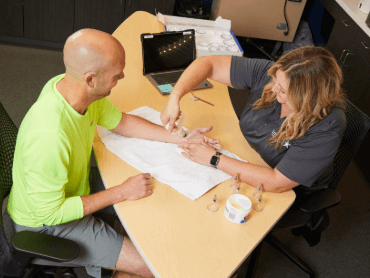Hand Injuries and Pain
Treating your hand and wrist injuries

As an essential part of daily life, your hands and wrists are sensitive to injury. Baylor Scott & White Institute for Rehabilitation - Outpatient Therapy uses a team approach for treating hand injuries, so you can resume your normal activities as quickly and comfortably as possible.
Our team provides expert care for patients of all ages who are experiencing pain associated with:
- Trigger finger
- Carpal tunnel syndrome
- Sprains and strains
- Dislocations
- Arthritis
- Tendonitis of the thumb
- Wrist sprain
Regardless of your injury, Baylor Scott & White Institute for Rehabilitation Outpatient Therapy will work with you to create a personalized treatment plan to get you on the road to recovery and back to the things that are important to you.
-
Bursitis is a painful condition that affects the small fluid-filled sac that support joints. It’s common on the elbow, shoulder, knee or hip. Symptoms of bursitis can include:
- Catching feeling
- Limited movement
- Pain or stiffness
- Popping or clicking sensation when moving your finger
Your treatment plan will focus on strengthening the muscles near the elbow to ease the pain and prevent the injury from recurring. Rest, ice and pain relievers can ease pain from bursitis.
-
Cubital tunnel syndrome is a condition that includes pressure or stretching of the funny bone in your elbow. Symptoms of cubital tunnel syndrome can include:
- Pain and numbness in the elbow
- Tingling and numbness in the ring and little fingers
Our certified hand therapists may suggest changes at your workplace or different ways to do your job or daily tasks to eliminate stress to your nerve.
-
Sprains and strains can occur in fingers or your wrists. The difference between a sprain and a strain is that a sprain injures the tissue that connects two bones, and a strain involves an injury to a muscle or the tissue that attaches a muscle to a bone. Symptoms of sprains and strains can include:
- Bruising
- Limited range of motion
- Pain
- Swelling
Your treatment can include strengthening, stability and stretching exercises for your finger or wrist.
-
A dislocation is an injury to a joint — where two or more bones come together— and can temporarily deform and limit mobility. Symptoms of dislocations include:
- Pain
- Swelling or bruising
- Inability to move your finger
- Your finger or wrist looks deformed or is sticking out to one side
Your treatment can include techniques or exercise to restore your range of motion, stability and strength.
-
Golfer’s elbow causes discomfort on the inner side of your arm and elbow. Symptoms of golfer’s elbow can include:
- Numbness or tingling in your ring and little fingers
- Pain and tenderness in the inner side of your elbow or forearm
- Stiffness
- Weakness in your hands and wrists
Your treatment plan may include soft tissue massage, and elbow, forearm and wrist stretches to help with movement.
-
Tennis elbow is the result of damaged tendons on the outside of your elbow. Symptoms of tennis elbow can include:
- Pain that radiates into your forearm and wrist
- Difficulty gripping
- Increased pain when lifting or opening objects
- Stiffness in your elbow
- Weakness in your forearm, wrist or hand
-
Tendonitis of the thumb affects the tendons on the thumb side of your wrist. Symptoms of thumb tendonitis can include:
- Difficulty flexing the thumb
- Difficulty grasping or pinching
- Limited motion or weakness
- Pain or swelling at the wrist where your thumb is attached to the forearm
Get the Help You Need. No Prescription Required
Restrictions Apply